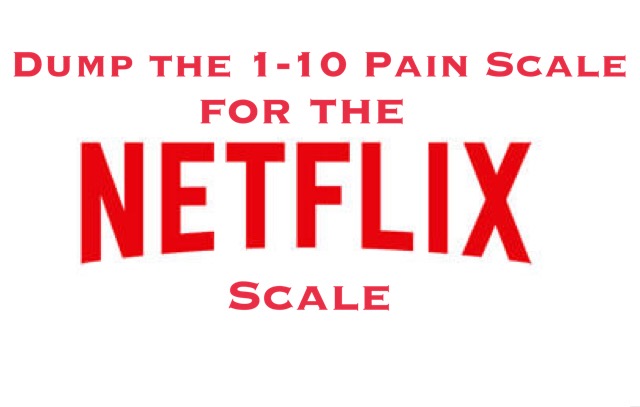When you suffer from chronic pain, the 1-10 pain scale is a joke. (Rate your pain from nothing to your worst ever, from 1-10, in case your fortunate enough not to be familiar with it.)
In reality, that scale is a joke anyway because it’s totally subjective. Someone’s ten might be someone else’s five. In fact, this ridiculous scale is part of what makes it so hard for chronic pain patients to “prove” we’re really in such significant pain. When you’re in pain all the time, especially when you’re in a situation like mine in which the pain level doesn’t vary much, asking me to rate it is kind of like asking for me to tell you what my leg feels like without touching it with my hands. It’s just there. Always there. I can’t rate how “present” my leg is in a practical way. One of my friends with chronic pain jokingly said that every time she’s asked to rate her pain it feels like she’s taking a test she’s about to fail.
Personally, I feel like a quality-of-life based pain scale for chronic pain is much more practical. Instead of asking me to give you some arbitrary number that means nothing to a doctor who probably has never had to live with anything more than temporary pain, ask me how the pain affects my daily life instead. Was I able to work? Socialize? Do housework?
That’s why I personally use the Netflix Scale for my pain.
My headache makes it almost impossible for me to read more than a few lines, and audiobooks aren’t a solution either partially because I’m sound sensitive and partially because that misses the point. I can’t read partially because I’m not able to concentrate. I hate it because I used to be an avid, “a book a day” kind of reader. Due to my sound sensitivity, I actually do most of my reading via captions as I’m more comfortable watching TV with the volume turned down. So since my headache started, I watch a lot of Netflix, and I can judge how bad my pain is depending on what I’m able to watch.
VERY LOW – I’m not on the couch watching TV but am actually able to do housework or socialize. A very good day!
LOW – a BBC drama – something with a really slow-moving, complicated plot you really need to pay attention to.
MEDIUM – a HBO drama – more complex than your average network show, but a little less brain power needed than a British program.
HIGH – shallow TV show (like Grimm, Arrow, Sleepy Hollow) – the kind of show where missing a detail or two won’t harm your ability to follow the story.
VERY HIGH – cooking show or game show (like Cupcake Wars or Guys Grocery Games) – no story to follow and lots of repetition because of commercial breaks in case I miss something.
I’M BARELY CONSCIOUS & TV IS HELPING ME KEEP MY SANITY BY DISTRACTING ME – Nature shows (I especially like the Wildest series. I’ve probably watched every single episode three or four times because when I’m in this much pain I mostly just watch and don’t bother reading the captions.) Brain power is at its minimum.
So that’s how I personally can tell how bad I’m feeling. What level of show I’m up to watching or can manage to follow. There are times I’m having a relatively good day and I think I can follow a BBC program only to realize that I’ve gotten lost pretty quick and will have to re-watch it later.
In all seriousness, though, we really need to stop using the 1-10 pain scale for chronic pain patients. Doctors need to ask how the pain is affecting the person’s daily life. If they can’t work, can’t go out, can’t do laundry, can’t sleep because of the pain, who cares what it is on a made-up 1-10 scale. Obviously, that person needs relief and sympathy rather than judgment.










